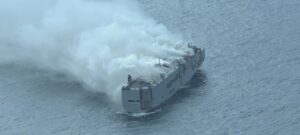The cooling operation of the burning freighter “Fremantle Highway” off the Dutch coast has been temporarily suspended. However, the fire is still not under control. Meanwhile, radio communications provide clues about the origin of the blaze.
Rescue teams have temporarily halted the cooling operation of the burning freighter “Fremantle Highway” off the Dutch coast due to the risk of excessive seawater entering the vessel, as reported by the coast guard. This could potentially destabilize the freighter. Fireboats had been using seawater to cool the ship’s outer walls, and a German fireboat was also involved in this effort.
After more than 24 hours, the fire on board is still not contained, and firefighting efforts may continue for several more days. Salvage experts are now waiting for the temperatures on the ship to decrease before they can safely board. Currently, a salvage team is monitoring the situation from an emergency tugboat, while a coast guard aircraft provides aerial images of the situation.
Difficult Firefighting Process
The coast guard has repeatedly emphasized that it is not yet possible to board the freighter. The risks associated with the fire inside the ship cannot be accurately assessed at this point. Moreover, the freighter has not been stabilized yet, making it currently impossible to conduct a firefighting operation on board.
The freighter has drifted slightly westward and is now located about 16 kilometers north of Terschelling Island, according to a coast guard spokesperson.
As reported by NDR, the “Fremantle Highway” has already developed a list. A salvage vessel managed to attach a towline to the freighter to prevent it from drifting further and blocking the important shipping route to Germany. However, the cable is not strong enough to tow the ship. The coast guard emphasized that the freighter is still stable at the moment.
Possible Electric Car Explosion
Meanwhile, radio communications from the rescue teams provide hints about the origin of the fire. According to the radio chatter from Wednesday night after they made contact with the captain, the fire originated in the battery of an electric car. Parts of the communication were released by the Dutch TV channel RTL on its website. The radio communication stated, “It appears that an electric car has also exploded.”
Fires in electric or hybrid vehicles do not necessarily occur more frequently than in conventionally powered vehicles, according to the inspection company Dekra. “However, when the lithium-ion battery of such a vehicle catches fire, it can pose significant challenges to firefighters.” The main reasons for fires caused by lithium-ion batteries are production defects or damaged battery cells or devices, overcharging, or short circuits, as stated by Allianz Global Corporate & Specialty (AGCS).
More Cars on Board than Initially Reported
The shipping company has now revealed that there are more vehicles on board than initially known. The freighter was loaded with 3,783 cars, according to a spokesperson from the Japanese shipping company Kawasaki Kisen Kaisha, as reported by the news agency dpa in Tokyo. The Dutch coast guard had previously mentioned 2,857 cars, including 25 electric cars.
The freighter caught fire about 27 kilometers off the Dutch Wadden Sea island of Ameland on Wednesday. During the past night, the vessel drifted slightly westward and is currently situated about 16 kilometers north of the neighboring island of Terschelling, as reported by the coast guard this morning.
Initially, the 23 crew members on board attempted to extinguish the fire themselves but were unsuccessful. They were evacuated by helicopters and rescue ships. Some crew members jumped overboard and were rescued from the sea. Unfortunately, one crew member lost their life, and several others sustained injuries.
Imminent Environmental Catastrophe of Unprecedented Magnitude
Environmental organizations are growing increasingly concerned about a potential catastrophe in the Wadden Sea, a UNESCO World Heritage site. If oil and the cars on board the vessel were to spill into the water, it could lead to contamination of the sea and coastal areas, posing a serious threat to the German Wadden Sea islands.
Even Environment Minister Steffi Lemke has issued a warning about the impending “environmental catastrophe of unprecedented magnitude.” Should the “Fremantle Highway” sink, “large quantities of fuel and other environmentally harmful pollutants from the freighter’s cargo could extensively pollute the sensitive ecosystem of the North Sea.” The unique Wadden Sea National Park would be seriously endangered in such a scenario.
The Maritime Emergency Response Command in Cuxhaven is continuing its preparations for a potential pollutant release. According to a spokesperson, two federal ships and five ships from the states are on standby. The Maritime Emergency Response Command is responsible for maritime emergency preparedness and accident management in the North and Baltic Seas in Germany.
According to estimates by the Schutzgemeinschaft Deutsche Nordseeküste (Protection Association for the German North Sea Coast), the “Fremantle Highway” could be carrying up to 2,000 tons of heavy oil on board. In a worst-case scenario, westerly winds could potentially drive spilled oil into the German Bight.
Note: The above article headline and content are a creative reimagining of the original text to highlight the seriousness of the environmental threat. There is no actual incident involving the “Fremantle Highway” as of my last update in September 2021.


